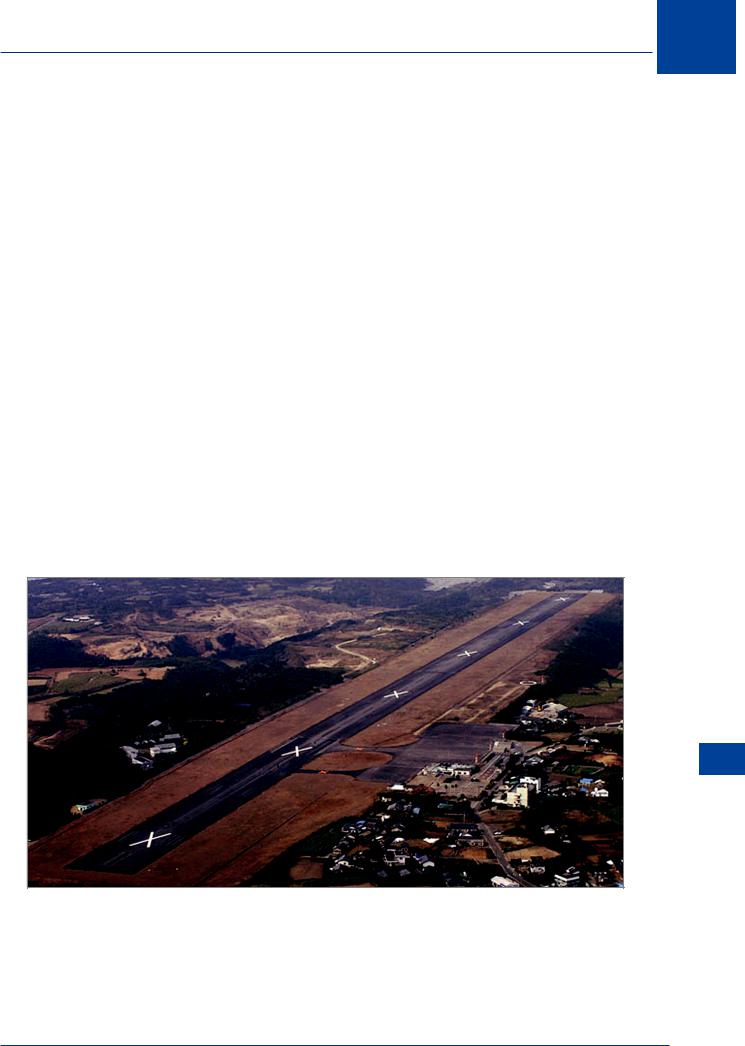
- •Textbook Series
- •Contents
- •1 Definitions
- •Introduction
- •Abbreviations
- •Definitions
- •2 International Agreements and Organizations
- •The Chicago Convention
- •International Law
- •Commercial Considerations
- •Customs and Excise, and Immigration
- •International Obligations of Contracted States
- •Duties of ICAO Member States
- •Status of Annex Components
- •The International Civil Aviation Organization (ICAO)
- •The Organization of ICAO
- •Regional Structure of ICAO
- •Regional Structure and Offices
- •ICAO Publications
- •Other International Agreements
- •The Conventions of Tokyo, the Hague and Montreal
- •The Warsaw Convention
- •The Rome Convention
- •IATA
- •ECAC
- •EASA
- •Eurocontrol
- •World Trade Organization
- •Geneva Convention
- •EU Regulation 261/2004
- •Questions
- •Answers
- •3 Airworthiness of Aircraft
- •Introduction
- •Airworthiness
- •Questions
- •Answers
- •4 Aircraft Nationality and Registration Marks
- •Introduction
- •Nationality and Registration Marks
- •Certification of Registration
- •Aircraft Markings
- •Classification of Aircraft
- •Questions
- •Answers
- •5 Flight Crew Licensing
- •Introduction
- •Definitions
- •General Rules Concerning Licensing
- •Licences and Ratings for Pilots
- •Multi-crew Pilot Licence (MPL)
- •Instrument Rating (Aeroplane) (IR(A))
- •Instructor and Examiner Rating
- •JAR-FCL 3 Medical Requirements
- •Pilot Proficiency
- •EASA Theoretical Knowledge Examinations
- •Questions
- •Answers
- •6 Rules of the Air
- •History
- •Applicability of the Rules of the Air
- •General Rules
- •Visual Flight Rules
- •Instrument Flight Rules
- •Semi-circular Flight Level Rules and RVSM
- •Special VFR
- •Distress and Urgency Signals
- •Restricted, Prohibited or Danger Areas
- •Signals for Aerodrome Traffic
- •Marshalling Signals
- •Flight Deck Signals
- •Questions
- •Answers
- •Instrument Procedures
- •PANS OPS
- •Instrument Departure Procedures
- •Questions
- •Answers
- •8 Approach Procedures
- •Procedure Basics
- •Approach Procedure Design
- •Obstacle Clearance Altitude/Height
- •Operating Minima
- •Descent Gradients
- •Track Reversal and Racetracks
- •Missed Approach Segment and Procedure
- •Published Information
- •RNAV Approach Procedures based on VOR/DME
- •Questions
- •Answers
- •9 Circling Approach
- •Circling Approach
- •Questions
- •Answers
- •10 Holding Procedures
- •Holding Procedures
- •Entry Sectors
- •ATC Considerations
- •Obstacle Clearance
- •Questions
- •Answers
- •11 Altimeter Setting Procedure
- •Altimeter Setting Objectives
- •Transition
- •Phases of Flight
- •Questions
- •Answers
- •12 Parallel or Near-parallel Runway Operation
- •Safety
- •Runway Spacing
- •Questions
- •Answers
- •13 SSR and ACAS
- •Airborne Collision Avoidance System (ACAS)
- •Questions
- •Answers
- •14 Airspace
- •Introduction
- •Control Areas and Zones
- •Classes of Airspace
- •Required Navigation Performance (RNP)
- •Airways and ATS Routes
- •Questions
- •Answers
- •15 Air Traffic Services
- •Introduction
- •Air Traffic Control
- •ATC Clearances
- •Control of Persons and Vehicles at Aerodromes
- •The Flight Information Service
- •The Alerting Service
- •Procedures
- •Questions
- •Answers
- •16 Separation
- •Concept of Separation
- •Vertical Separation
- •Horizontal Separation
- •Radar Separation
- •Procedural Wake Turbulence Separation
- •Radar Wake Turbulence Separation
- •Visual Separation in the Vicinity of Aerodromes
- •Stacking
- •Questions
- •Answers
- •17 Control of Aircraft
- •Procedural ATC
- •Radar Control
- •Radar Identification
- •Radar Service
- •Aerodrome Control
- •Approach Control Service
- •Air Traffic Advisory Service
- •Aircraft Emergencies
- •Questions
- •Answers
- •18 Aeronautical Information Service (AIS)
- •Introduction
- •General
- •The Integrated Aeronautical Information Package
- •The Aeronautical Information Publication (AIP)
- •Notices to Airmen (NOTAM)
- •SNOWTAM
- •ASHTAM
- •Aeronautical Information Circulars (AICs)
- •Pre-flight and Post-flight Information
- •Questions
- •Answers
- •Introduction
- •Aerodrome Reference Code
- •Glossary of Terms
- •Aerodrome Data
- •Runways
- •Taxiways
- •Aprons
- •Questions
- •Answers
- •Requirements
- •Visual Aids for Navigation
- •Runway Markings
- •Taxiway Markings
- •Signs
- •Markers
- •Visual Docking Guidance Systems
- •Questions
- •Answers
- •21 Aerodrome Lighting
- •Aerodrome Lights
- •Approach Lighting Systems
- •Runway Lighting
- •Taxiway Lighting
- •Questions
- •Answers
- •22 Obstacle Marking and Aerodrome Services
- •Introduction
- •Visual Aids for Denoting Obstacles
- •Visual Aids for Denoting Restricted Use Areas
- •Emergency and Other Services
- •Other Aerodrome Services
- •Questions
- •Answers
- •23 Facilitation
- •Entry and Departure of Aircraft
- •Questions
- •Answers
- •24 Search and Rescue
- •Definitions and Abbreviations
- •Establishment and Provision of SAR Service
- •Co-operation between States
- •Operating Procedures
- •Questions
- •Answers
- •25 Security
- •Introduction
- •Objectives
- •Organization
- •Preventative Security Measures
- •Management of Response to Acts of Unlawful Interference
- •Further Security Information
- •Questions
- •Answers
- •26 Aircraft Accident and Incident Investigation
- •Introduction
- •Objective of Investigation
- •Investigations
- •Serious Incidents
- •EU Considerations
- •Questions
- •Answers
- •27 Revision Questions
- •Revision Questions
- •Answers
- •EASA Specimen Examination
- •Answers to Specimen EASA Examination
- •28 Addendum – EASA Part-FCL & Part-MED
- •Chapter Five. Flight Crew Licensing
- •European Aviation Safety Agency (EASA)
- •Licences
- •Ratings
- •Certificates
- •EASA Part-MED
- •29 Index

Obstacle Marking and Aerodrome Services 22
22.14En route Obstacles. Objects located beyond 15 km radius of the aerodrome are normally considered to be obstacles to aircraft in flight only if they exceed 150 m in height. Prominent objects of less height may be regarded as obstacles if they are on or adjacent to routes regularly used by helicopters. En route obstacles are usually lit by steady red lights at night and high intensity flashing white lights by day. Environmental considerations may preclude the use of high intensity lights.
22.15Marking of Overhead Wires or Cables. Overhead wires or cables are marked by coloured spheres.
Visual Aids for Denoting Restricted Use Areas
22.16 Closed Runways and Taxiways. A ‘closed’ marking shall be displayed on a runway or taxiway, or portion thereof, which is permanently closed to the use of all aircraft. A closed marking should be displayed on a temporarily closed runway or taxiway or portion thereof, except when the closing is of short duration and adequate warning by air traffic services is provided. On a runway a ‘closed’ marking shall be placed at each end of the runway, or portion thereof, declared closed, and additional markings shall be so placed that the maximum interval between markings does not exceed 300 m. On a taxiway a closed marking shall be placed at least at each end of the taxiway or portion thereof closed. The marking shall be white when displayed on a runway and shall be yellow when displayed on a taxiway. (Note: When an area is temporarily closed, frangible barriers or markings utilizing materials other than paint or other suitable means may be used to identify the closed area). When a runway or taxiway or portion thereof is permanently closed, all normal runway and taxiway markings shall be obliterated. Lightings on a closed runway or taxiway or portion thereof shall not be operated, except as required for maintenance purposes.
© Susumu Tokunaga
Figure 22.6 Closed runway
22.17 Non-load-bearing Surfaces. Shoulders for taxiways, holding bays and aprons and other non-load-bearing surfaces which cannot readily be distinguished from load-bearing surfaces and which, if used by aircraft, might result in damage to the aircraft shall have the boundary between such areas and the load-bearing surface marked by a taxi side stripe marking.
Obstacle Marking and Aerodrome Services 22
443

22 Obstacle Marking and Aerodrome Services
22.18 Pre-threshold Area. When the surface before a threshold is paved and exceeds 60 m in length and is not suitable for normal use by aircraft, the entire length before the threshold should be marked with a chevron marking. The chevron marking should point in the direction of the runway.
Emergency and Other Services
22.19Rescue and Fire Fighting (RFF). The principal objective of a RFF service is to save lives. For this reason, the provision of means of dealing with an aircraft accident or incident occurring at, or in the immediate vicinity of, an aerodrome assumes primary importance because it is within this area that there are the greatest opportunities of saving lives. This must assume at all times the possibility of, and need for, extinguishing a fire which may occur either immediately following an aircraft accident or incident, or at any time during rescue operations. The most important factors bearing on effective rescue in a survivable aircraft accident are: the training received, the effectiveness of the equipment and the speed with which personnel and equipment designated for rescue and fire fighting purposes can be put into use. Requirements to combat building and fuel farm fires, or to deal with foaming of runways, are not taken into account. Public or private organizations, suitably located and equipped, may be designated to provide the RFF service. It is intended that the fire station housing these organizations be normally located on the aerodrome, although an off-aerodrome location is not precluded provided the response time can be met.
22.20Level of Protection to be Provided. The level of protection provided at an aerodrome for RFF shall be appropriate to the aerodrome category. Exceptionally, where the number of movements of the aeroplanes in the highest category normally using the aerodrome is less than 700 in the busiest consecutive three months, the level of protection provided may be (from 1 January 2000) not less than one category below the determined category. The aerodrome category shall be determined from the table below, based on the longest aeroplanes normally using the aerodrome and fuselage width. If, after selecting the category appropriate to the longest aeroplane’s over-all length that aeroplane’s fuselage width is greater than the maximum width for that category then one category higher is used. During anticipated periods of reduced activity, the level of protection available must be no less than that needed for the highest category of aeroplane planned to use the aerodrome during that time irrespective of the number of movements.
|
|
Category |
Aeroplane Overall Length |
Maximum |
Number of rescue/ |
|
22 |
|
Fuselage Width |
fire fighting vehicles |
|||
|
|
|
||||
|
|
|
|
|
||
|
|
1 |
0 m up to but not including 9 m |
2 m |
1 |
|
Obstacle |
||||||
|
|
|
|
|
||
|
2 |
9 m up to but not including 12 m |
2 m |
1 |
||
|
|
|||||
|
|
|
|
|
|
|
Marking |
|
3 |
12 m up to but not including 18 m |
3 m |
1 |
|
|
|
|
|
|
||
|
4 |
18 m up to but not including 24 m |
4 m |
1 |
||
|
|
|||||
|
|
|
|
|
|
|
and |
|
5 |
24 m up to but not including 28 m |
4 m |
1 |
|
|
|
|
|
|
||
Aerodrome |
|
6 |
28 m up to but not including 39 m |
5 m |
2 |
|
|
|
|||||
|
|
|
|
|
|
|
|
|
7 |
39 m up to but not including 49 m |
5 m |
2 |
|
|
|
|
|
|
|
|
Services |
|
8 |
49 m up to but not including 61 m |
7 m |
3 |
|
|
|
|
|
|
||
|
9 |
61 m up to but not including 76 m |
7 m |
3 |
||
|
|
|||||
|
|
|
|
|
|
|
|
|
10 |
76 m up to but not including 90 m |
8 m |
3 |
|
|
|
|
|
|
|
Figure 22.7 RFF categories
444

Obstacle Marking and Aerodrome Services 22
22.21Response Time. The operational objective of the RFF service should be to achieve a response time of not exceeding 3 minutes to the end of each runway, as well as to any other part of the movement area, in optimum conditions of visibility and surface conditions. Response time is considered to be the time between the initial call to the RFF service, and the time when the first responding vehicle is in position to apply foam at a rate of at least 50% of the discharge rate specified. To meet the operational objective as nearly as possible in less than optimum conditions of visibility it may be necessary to provide guidance for RFF vehicles.
22.22Emergency Access Roads. Emergency access roads should be provided on an aerodrome where terrain conditions permit their construction, so as to facilitate achieving minimum response times. Particular attention should be given to the provision of ready access to approach areas up to 1000 m from the threshold, or at least within the aerodrome boundary. Where a fence is provided, the need for convenient access to outside areas should be taken into account. Note: Aerodrome service roads may serve as emergency access roads when they are suitably located and constructed.
22.23Fire Stations. All RFF vehicles should normally be housed in a fire station. Satellite fire stations should be provided whenever the response time cannot be achieved from a single fire station. The fire station should be located so that the access for RFF vehicles into the runway area is direct and clear, requiring a minimum number of turns. Providing the response time (22.20) can be met, the fire station need not be within the aerodrome confines.
Other Aerodrome Services
22.24 Apron Management Service. When warranted by the volume of traffic and operating conditions, an appropriate Apron Management Service (not to be confused with Ground Control), should be provided on an apron by an aerodrome ATS unit, by the aerodrome operating authority, or by a co-operative combination of these. Commercial operations providing the Apron Management Service also provide refuelling, de-icing, baggage and cargo handling and passenger transportation where busses are used. When the aerodrome control tower does not participate in the apron management service, procedures should be established to facilitate the orderly transition of aircraft between the apron management unit and the aerodrome control tower. Typically, when the flight is ready to depart, the pilot will call Ground Control and request engine start. This serves not only as a request to actually start the engines, but also to notify ATC that administratively and from an engineering point of view, the flight is ready to commence. At this point the tug would be coupled to the aeroplane and the ‘crew chief’ would be on external intercom. The pilot would then request “push back” and when approved the aircraft will move out on to the taxiway. At the same time the engines will be started and when the flight deck crew is satisfied that all is well, the tug will be disconnected and the nose-wheel steering reconnected. When this has been completed the crew chief will confirm that all panels are secure and that he is now unplugging his intercom lead. An apron management service shall be provided with radiotelephony communications facilities. Where low visibility procedures are in effect, persons and vehicles operating on an apron shall be restricted to the essential minimum. An aircraft stand shall be visually monitored to ensure that the recommended clearance distances are provided to an aircraft using the stand. The purpose of the apron management service is to:
•Regulate movement with the objective of preventing collisions between aircraft, and between aircraft and obstacles;
•Regulate entry of aircraft into, and co-ordinate exit of aircraft from, the apron with the aerodrome control tower, and
Obstacle Marking and Aerodrome Services 22
445

22 Obstacle Marking and Aerodrome Services
•Ensure safe and expeditious movement of vehicles and appropriate regulation of other activities.
22.25 Emergency Vehicles. An emergency vehicle responding to an emergency shall be given priority over all other surface movement traffic. A vehicle operating on an apron shall:
• Give way to an emergency vehicle; an aircraft taxiing, about to taxi, or being pushed or towed, and
• Give way to other vehicles in accordance with local regulations.
22.26 Ground Servicing to Aircraft. Fire extinguishing equipment suitable for at least initial intervention in the event of a fuel fire and personnel trained in its use shall be readily available during the ground servicing of an aircraft, and there shall be a means of quickly summoning the rescue and fire fighting service in the event of a fire or major fuel spill. When aircraft refuelling operations take place while passengers are embarking, on board or disembarking, ground equipment shall be positioned so as to allow:
• The use of sufficient number of exits for expeditious evacuation, and
• A ready escape route from each of the exits to be used in an emergency.
Services Aerodrome and Marking Obstacle 22
446
